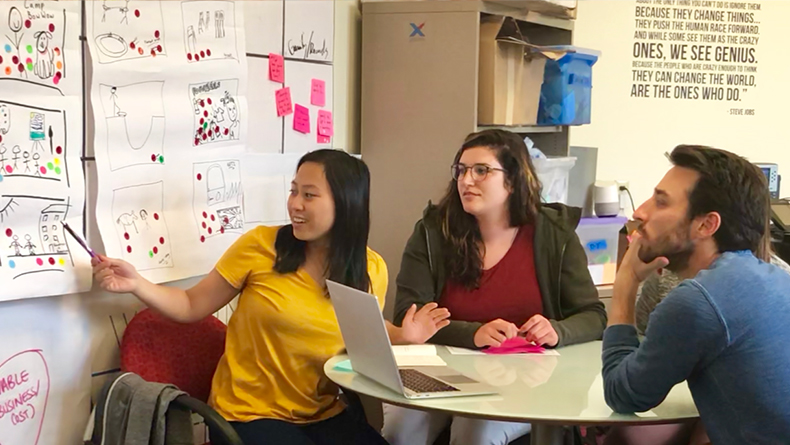New interdisciplinary course applies design-thinking to develop solutions for youth experiencing homelessness

How do we support youth experiencing homelessness in building meaningful connections? This was the challenge put to students in the University of Denver’s inaugural human-centered design seminar.
Offered in spring 2018, the interdisciplinary course included 13 students from the Graduate School of Social Work (GSSW), the Korbel School of International Studies, Daniels College of Business, Ritchie School of Engineering & Computer Science, and the Emergent Digital Practices program in the College of Arts, Humanities and Social Sciences. Students worked in three teams to develop and pitch solutions in collaboration with youth at Urban Peak, a nonprofit serving youth experiencing homelessness.
Human-centered design includes the human perspective in all aspects of problem-solving, from empathizing to iterating, prototyping and pitching. “The human-centered design process helps us to think outside of our traditional bureaucracy and helps us get unstuck in addressing challenges,” says GSSW Professor Kim Bender, associate dean for doctoral education. “It’s a problem-solving approach that could be a useful tool in social workers’ toolbox.”
Bender and computer science Associate Professor Matt Rutherford developed and taught the course—an outgrowth of two previous homelessness hackathons—in partnership with GSSW PhD student Jennifer Wilson and MSW student Ellie Adelman. Bender and Rutherford are Faculty Innovation Fellows in Project X-ITE, the University’s incubator for innovation and social entrepreneurism, and Bender is the Project X-ITE academic director.
The course was funded through a DU Grand Challenges Scholar Grant from the Center for Community Engagement to Advance Scholarship and Learning, and the National Center on Excellence in Homeless Services supported course evaluation.
It is challenging to get young people experiencing homelessness to engage in services, partially due to lack of connection and trust, Bender says. To better understand this challenge, students met with youth experiencing homelessness and engaged them in activities such as mapping connections, card sorts and sharing symbols of connection with one another. Students then brainstormed and prototyped ideas for how connection could be developed and brought those ideas back to Urban Peak for feedback; they changed or refined solutions based on youth feedback.
“Design thinking involves embracing new mindsets, including ambiguity and risk of failure,” says Bender, noting that the course’s use of design thinking has been highlighted as an important approach for addressing the Social Work Grand Challenge to End Homelessness. “Even if ideas go nowhere, the learning still takes place.”
For instance, one student group initially proposed an idea for a youth-governed tree house social space, but youth expressed concerns with the idea. “We went with an idea of a tree house but ended up developing supports through a summer camp where youth would become trained employees, receive professional development, stable housing, income and food,” says Sydney Zorensky, MSW ’18. “There’s no way we would have gotten to the idea we did without their support, criticism, laughter, insight; it was all based on what youth provided. They felt so part of the work and honored to be part of the process of innovation based on their feedback.”
Mae Thompson, BA international studies ’18 (the only undergraduate in the graduate-level seminar), is applying the lessons learned in the course to her work at Safehouse Progressive Alliance for Nonviolence. “I work with young people, and I see that their lived experience is something we should learn from,” she says. “Instead of just coming up with ideas ourselves, we need to engage them in the process.”
Bender, Rutherford and team used a human-centered design approach to develop the course itself. In the spirit of the human-centered design process, they hope to hand off the course design to other faculty members to further innovate and refine. Human-centered design and design thinking will also continue to be part of The Social, an annual social innovation networking event hosted by GSSW, Project X-ITE and the Barton Institute for Philanthropy and Social Enterprise.
Application of human-centered design principles is not common in social work, but it should be, Bender says. “We as social workers have a lot to offer in social innovation—we have connections with people and communities with needs, and skill in supporting communities and honoring their wisdom. But we can learn a lot from integrating perspectives from fields that haven’t always been at the table. We may have to be more adaptable and try something before it’s 100-percent ready.”
“I don’t know if human-centered design has figured out how to address complex social issues,” Bender adds, “but I would love to see social work lead in applying this approach to complex systems and social issues.”


Recent Comments